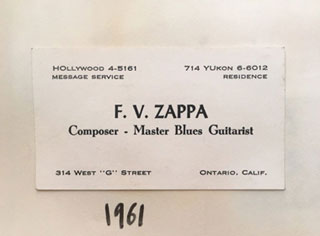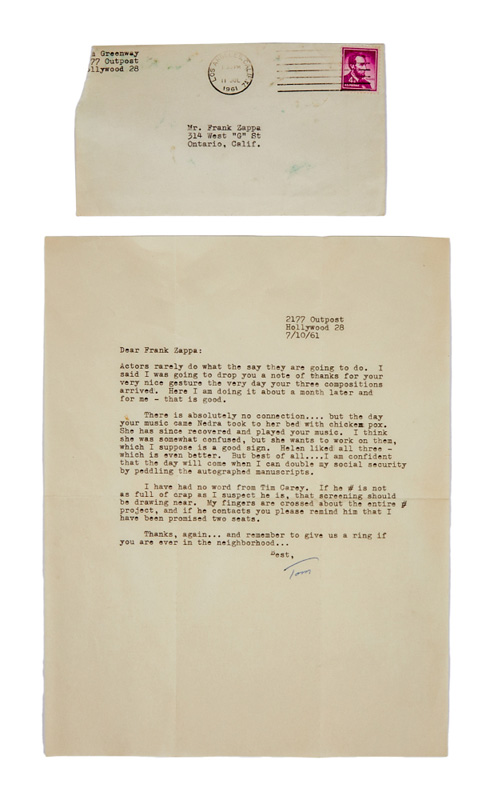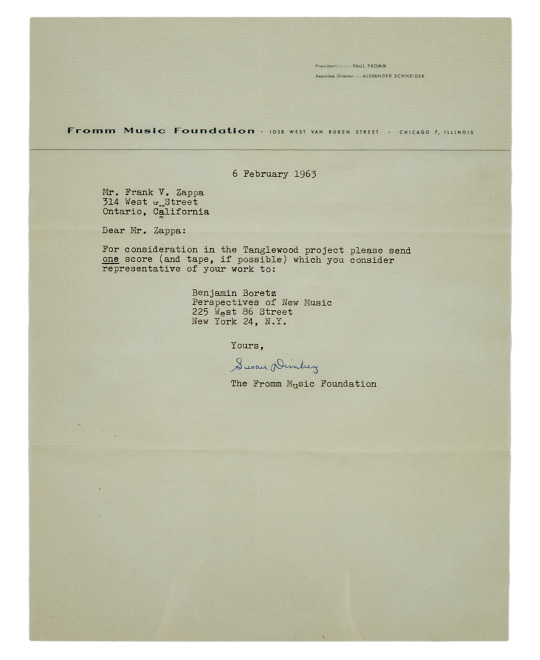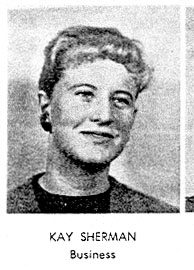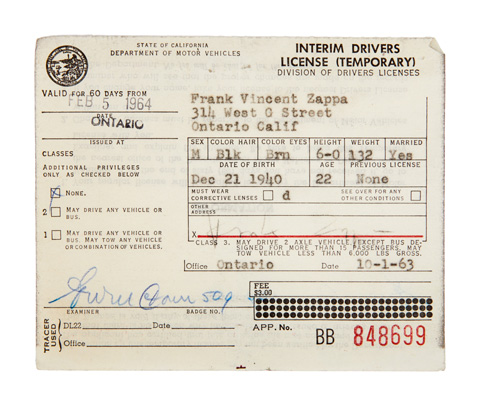1961-1962—The Blackouts
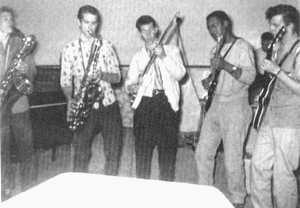
[Jim Sherwood, baritone sax; Dwight Bement, tenor sax; Ronnie Williams, guitar; Johnny Franklin, guitar; FZ, drums; Alex Snouffer, guitar.]
Sharva Maynard, July 18, 2007
I noticed in your chronology of FZ, (1961-62) a photo of the Blackouts with a question mark for guitar player in picture (far right). It is Alex (Butch) Snouffer.

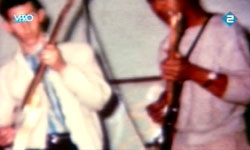

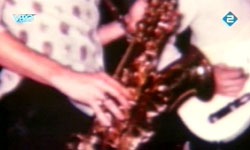

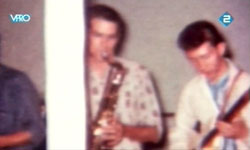
Our first band was called the Fydallions, started in 1957 and ran to 1959, (approx). I played tenor and Ronnie [Williams] played lead guitar. [...] I didn't play in the Ramblers but I was in the Nomads for a while.
Sometime after the Nomads, I moved to Sacramento (1960) and teamed with Steve Baptiste, Dave Erwin, Ross Owen and Denny (?). We called this band the Fydallions. After I went back to San Diego in 1961, the Fydallions went through several changes, eventually becoming the Spiral Staircase.
I think I was in San Diego about two days when Ronnie called and asked me to come up to Ontario and join his band. I didn't hesitate. He was living with his parents at the time so I moved in. This is when the infamous 'Green Window' project was launched. You can read about it elsewhere.
His band, the Blackouts, included Frank Zappa, Joe [Perrino] (piano), Al [Surratt] (drums) and possibly, a large guitarist/blues singer/harmonica player by the name of 'Restless' Rex [Jakabosky], (I wonder where he is, he was wonderful). I was in that band in 1961 and 1962. During that time, we were ocassionally joined by Jim Sherwood and others to play up in Lancaster at the community center. These events were usually 'Battles of the Bands'. The photo of me on one of your sites and the photo of me in The Real Frank Zappa Book (page 45), were taken at that time, during a rehearsal, possibly at the Franklin home east of Lancaster.
[...] When I first joined FZ, w/Ronnie [Williams], Joe [Perrino] and Al [Surratt], we played in a bar in Pomona. 7 nites a week, for 3 months. $9 a nite each. I guess I'm not sure of the band's name, but ocassionally, we would drive up to Lancaster and play a battle against some other bands that FZ knew. We would add some different players and this band was the 'Blackouts'. The old photos of me were taken at these rehearsals in Lancaster, possibly out east at the Franklin home in Sun Valley or Sun something . . . I eventually moved from Ronnie's to Monterey Park, near East L.A. w/ Al Sarratt [Surratt] and his wife. Al got me a job where he worked. ABC Fairco, an aircraft bolt factory. We still worked w/ FZ.
[...] The end of 1962 or the beginning of 1963, Tommy Kendall came up to Ontario and 'shanghied' me back to San Diego to start another band, the Gentrys, not the band with a hit record. Ronnie either joined at the same time or shortly thereafter.
I followed Al Sarratt [Surratt] as drummer in the Do How Band with Ronnie & Kenny in 1973.
Around 1961, Mr. Jakabosky and Mr. Zappa ran into each other in a music store in Ontario, and re-established contact. Mr. Jakabosky started playing with the bands that Mr. Zappa was in (the Blackouts, the Soots . . . changing names often) during 1961 and 1962. He also was part of the people that Frank Zappa recorded with at studio Z in Cucamonga.
Frank had formed a few groups down in Ontario, and he would come up for battles of the bands all the time. It was kind of a kick.
When The Omens were playing Frank would get some of the guys together and they would come back up as The Blackouts. The black guys that were in the band were still living out in the village. Frank would just come to town and we would do a Battle of the Bands.
1962, original [...] Frank Zappa Band on stage, including picture of drummer Ron Williams holding birthday cake on the day Frank gave him [...] the Painting "Williams Special #2," Ron Williams gave it to his then girlfriend, the consignors' mother.
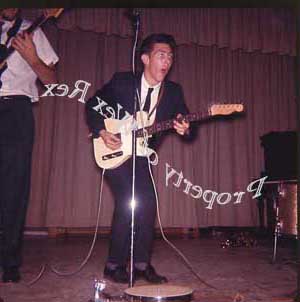
[Rex Jakabosky, guitar; Ronnie Williams, guitar (white Telecaster).]

[Ronnie Williams, guitar (white Telecaster); FZ, guitar (sunburst Jazzmaster).]
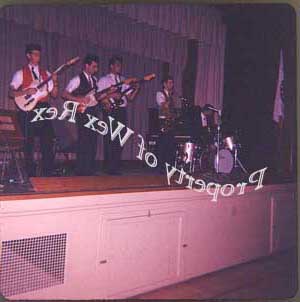
[Ronnie Williams (white Telecaster); FZ, guitar (sunburst Jazzmaster); Rex Jakabosky, guitar; Dwight Bement, tenor sax; Al Surratt, drums.]
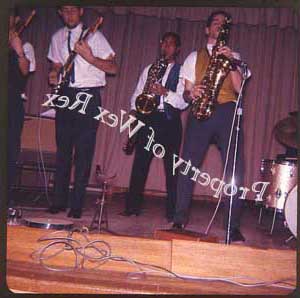
[FZ, guitar; Rex Jakabosky, guitar; Johnny Franklin, baritone sax; Dwight Bement, tenor sax.]
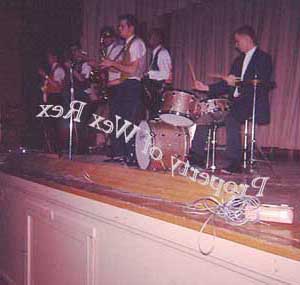
[Ronnie Williams (white Telecaster); FZ, guitar; Rex Jakabosky, guitar; Dwight Bement, tenor sax; Johnny Franklin, baritone sax; Al Surratt, drums.]

[Ronnie Williams and his birthday cake]

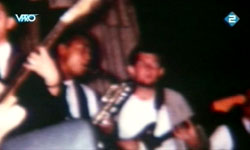
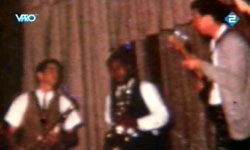
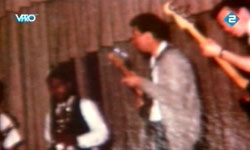
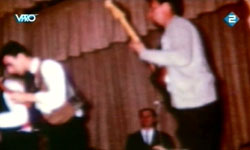
Meanwhile, The Zappa Family Still Kept Moving
The year 1960 [...] was slim pickings for work in California and Dad, ever the provider, had to go where the work was. So another move took us across county to Sarasota, Florida, and a teaching position for my father. Meanwhile, Bob had gone into the Marines in California.
The rest of us were constantly homesick for Los Angeles [...]. Dad finally gave in to our kvetching and we moved back.
Bobby Zappa, July 22, 2006
In 1961 our parents and our sister Candy and brother Carl moved to Sarasota, FL. I graduated from high school that year and after a short time joined the U.S. Marine Corps.
A few weeks before [my] graduation Dad called me into the living room and said, "I'm going to take a teaching job in Florida so we'll be moving soon. What are your plans?"
[...] I finally graduated from high school in the summer of 1961. Soon thereafter my parents, Carl, and Candy left for Florida.
November 1961-early 1962—Joe Perrino & The Mellotones
I was working weekends with a four-piece lounge band called Joe Perrino and the Mellotones, at Tommy Sandi's Club Sahara in San Bernardino.
The management allowed us to play one [1] 'twist number' per night. The rest of the night we were supposed to play "Happy Birthday," "Anniversary Waltz" and "On Green Dolphin Street." I wore a white dinner jacket and bow tie and black pants and sat on a bar stool and played the electric guitar. I got so sick of it that I quit, put the guitar in the case, stuck it behind the sofa and didn't touch it for eight months.
FZ, interviewed by Don Menn, "The Mother Of All Interviews, Part 1," Zappa!, 1992, p. 44
At one time weren't you a lounge musician?
Oh yeah, I had to do that, and at the end of it I put my guitar in the case and stuck it behind the sofa and didn't touch it I guess for a year. It was nauseating.
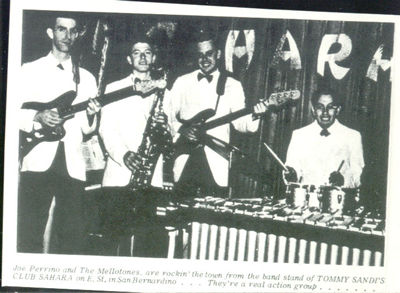
Joe Perrino and The Mellotones, are rockin' the town from the band stand of TOMMY SANDI'S CLUB SAHARA on E. St. in San Bernardino . . . They're a real action group . . . . . . [From left to right: FZ, Fender Jazzmaster guitar; Mike Dineri, sax; Joe Perrino, bass; Tommy Hernandez, drums.]
FZ, interviewed by Down Beat, February 1983
After [renting the Telecaster] I bought a Jazzmaster, which I used for about a year-and-a-half while playing lounge gigs at places like Tommy Sandy's Club Sahara in San Bernadino.
I bought a Jazzmaster which I used for about a year and a half. I used to play, like, lounge jobs—you know, sit on the stool, strum four chords to a bar, "Anniversary Waltz," "Happy birthday," one twist number per night, don't turn it up. All that kind of crap. Nobody else in the band really knew what the chord changes were to these dumb songs; they were all trying to figure out what was going on. I played places like Tommy Sandy's Club Sahara in San Bernardino, some clubs around West Covina. Really boring, miserable places. I worked with a group called Joe Perrino and the Mellow Tones.
After I got out of high school and moved away, I played other kinds of gigs, like a short stint with Joe Perrino and the Mellotones. We were allowed to play one twist number per night. The rest was "Happy Birthday," "Anniversary Waltz" and all the standards. I wore a little tux and strummed chords, bored. I got sick of that and stuck my guitar in the case and put it behind the sofa and left it there for eight months.
When the Boogie Men folded, [FZ] joined a 'really wretched' four-piece lounge band called Joe Perrino & The Mellotones. [...]
"You had to read songs out of a (thick) brown book, flip the pages in the dark and see what the chord changes were." [BBC-TV interview by Nigel Leigh] As well as the Club Sahara, the band oozed their way through gigs at the clubs around West Covina. "I could tolerate that for a short period of time (about ten months) but eventually I hated it so much, I just put the guitar in the case, stuck it behind the sofa and didn't play at all for about eight months." [Zappa! (Miller Freeman, 1992), "The Mother Of All Interviews."]
Two of the formal bands Zappa played with were The Boogie Men (1960-1962) and the four piece, San Bernardino-based Joe Perrino And The Mellotones (November 1961-early 1962).
Sebastian Anthony Battaglia, known professionally as Dino Dupree, was Frank Zappa's replacement in Joe Perrino And The Mellotones. In fact, Zappa taught Dino the band's set during this two-week changeover period. When Dino joined Perrino's group, they became The Gigolos.
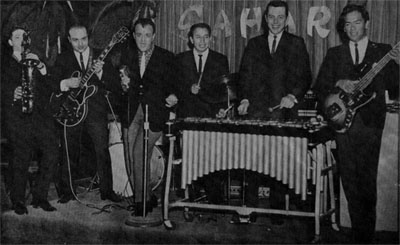
The Gigolos. From left to right, the band is Mike Dineri, Dino Dupree, Tommy Sandi, Tommy Hernandez, Joe Perrino and Manny Orosco.
Michael Brenna (March 9, 2011)
I think the photo of The Gigolos at p. 18 [of the Paul Buff Presents booklet] now identifies the members of Joe Perrino & The Mellotones in the Mystery Disc booklet photo, as the following: FZ (guitar) Mike Dineri (sax) Joe Perrino (here: bass) Tommy Hernandez (drums)
FZ takes Don Preston to an audition
One day around 1962 or '63, I don't remember exactly when, I received a call from Frank Zappa. He had an audition at a club in Santa Ana and he needed a keyboard player—it was typical of the organ/tenor sax/guitar trios that were popular at the time. So I went over to Zappa's house and we played the audition and . . . didn't get the job.
We actually played "Oh No" at the audition, which I thought was kind of bizarre because it wasn't that kind of a club. During the rehearsals though I happened to browse through Zappa's record collection and saw that he liked a lot of the same composers as I did, that we had similar musical tastes.
Don Preston, January 28, 2002
I met Zappa in the middle of 1961 but I remember Zappa telling me about the movie [The World's Greatest Sinner] later and I saw it when it came out. Even though I went to Zappa's house several times in 1961 I never met Kay [Sherman] or was aware that she existed. [...]
I never knew of any of those people [Ronnie Williams, Al Surratt, Dwight Bement, Jim Sherwood or Joe Perrino] at that time. I don't think the lounge band had a name. The band consisted of myself, Zappa and a drummer who I don't remember. I do remember playing "Oh No" during the audition. People were always calling me at that time to play these kinds of jobs. I think another keyboard player referred me to Zappa but I don't know who.
Don Preston, "First Meeting," Listen—A Thought, Faster Than Light, 2011, p. 24
"Hi my name is Frank Zappa." He said barely recognizable
"I play guitar." He shouted.
"I have an audition for a gig, you interested?"
I say yes and later went to his house to rehearse
The first thing I noticed was his record collection
Schoenberg, Berio, Berg, Cage and Varèse
Identical to mine.
We auditioned playing dance music in 7/4
People stumbled over his own legs
Didn't get the job.
I met Zappa somewhere around 1961. We struck up a friendship. He called me, and wanted me to audition with a little trio: organ, guitar and drums. So we went to this place in Santa Ana (California) called the Bank Club, and we auditioned there. We played "Oh No," which is in 7/4. People were trying to dance. We didn't get the gig.
C: How did you meet up with Jimmy Carl Black?
Z: He was working at a bar.
C: . . . and with Don Preston?
Z: Well with Don Preston, I met him when he wasn't working in a bar. You see, we planned to put a group together to get a job at a bar. He didn't have a job, and I didn't have a job, and we both went and auditioned for the same job . . . in a bar.
Michael Brenna, December 16, 2014
I talked to Bunk and Don after the Grandmothers show in Oslo recently, and asked how they first met FZ. Independently, both said that they were playing at some gig with their band, which also featured the band FZ was in. The "early sixties" was as close as I got. The gig had a multiple stage setup, and they played at the same stage as FZ's band. They didn't recall line-ups or anything, but said it was all about commercial, straightforward dance music. Don remembers exchanging business cards with Frank.
Frank had met Don Preston at the Unicorn club that Herbie used to run right next to the Whisky. Don used to play piano there, mostly jazz stuff. He only got to do the avant-garde stuff at home in the studio.
I was playing in this big huge room and there were like 6 other bands playing. There were 2 or 3 bandstands around the peripheral of the room, and there was a bandstand in the center of the room. It was really quite a large space. I found myself in the center stage, and I met Frank there. He was playing in a band that was on that stage as well. We talked... exchanged cards... and about 3 weeks later he called me. He wanted me to do an audition. So I came over to his house and went over some of his music. The group was organ, guitar, and drums. I can't remember who the drummer was. We went to play at this dance club, and Frank wanted us to play "Oh No", which was a beautiful piece but it's in 7/4. People can't dance to 7/4... it's very difficult. We didn't get that job.
1962—Young Musicians Foundation
Valley State Sundial, February 27, 1962, p. 3
$1000 Music Scholarships To Be Given
Eligible young musicians in this area are being lavited to enter the 1962 statewide auditions of the Young Musicians Foundation which will grant four $1,000 scholarships to those picked as California's best pianist, vocalist, string player and composer.
The application period, now open, will continue until May 1 for composers and May 25 for all other contestans. Applications must be sent to the foundation, Box 49955, L.A., 49, California.
The Southern California regionals are set for June 15, 16 and 17 in Schoenberg Hall, UCLA, and the finals are on June 23 at the same place.
Three world famous musicians are included in the finals auditions panel: Jascha Helfetz, violinist; Gregor Piatigorsky, cellist; and William Primrose, viola player.
Audition application forms are available in the music office, Music Building. For more forms or additional information, write the foundation.
Los Angeles Collegian, March 2, 1962, p. 4
State Music Contest Award Scholarships
Four $1000 scholarships will be awarded to those chosen as California's best pianist, vocalist, string player and composer by the Young Musicians Foundation.
All participants must be residents of the state, students enrolled in California schools or residents temporarily living outside the state, according to the competition rules.
Pianists and string players must not have reached the age of 26 by May 25, while singers and composers must not be 30 years old by that date.
The application period continues until May 1 fro composers and May 25 for all other contestans.
The Harmony Award, granted by the State of California to the foundation's "best in state" selections, will be awarded to each winner.
Information regarding applications is available in the music department.
Los Angeles Times, June 14, 1962, p. 15
REGIONAL AUDITIONS
8 Valley Musicians to Compete at UCLA
Eight young musicians from the San Gabriel Valley will compete in the Southern California regional auditions to be held Friday through Sunday at UCLA by the Young Musicians Foundation.
This is the semi-final event in the competition to select the state's best young vocalist, pianist, string player and composer. Statewide finals will be held June 23 in Schoenberg Hall, UCLA in a series of auditions before a panel of judges. Serving as judges will be Jascha Heifetz, violinist; Gregor Piatiagorsky, cellist and president of the Young Musicians Foundation; William Primrose, violinist and Rosa Raisa, singer.
Area entrants include vocalists Rachel Egelston, and Marguerite Hougasian, Pasadena and Kiyo Tashima of Alhambra.
Composers who will compete are Frank V. Zappa, Ontario; Ronald Arthur of Rosemead and John E. Wilson of Duarte.
Also entered are violinist Walter Verderber and pianist Marilyn Miller of La Canada.
Two winning vocalists, pianists and string players will compete against two finalists in each category chosen in Northern California regionals recently.
The winner in each category will receive a Young Musicians Foundation $1,000 cash award and be presented in television debut co-sponsored by the Los Angeles Junior Chamber of Commerce next September as well as in UCLA Royce Hall concert during the foundation's 1962-1963 concert series.
In addition, each winner will receive the "Harmony" award established by the State of California in 1961 to recognize the Young Musicians Foundation annual "best in state" selections.
Los Angeles Times, June 25, 1962, p. 31
L.A. Singer, Pianist Granted $1,000 Award
A vocalist and a pianist from Los Angeles and a violinist from Berkeley were chosen Sunday as 1962 winners of the annual Young Musicians Foundation awards.
Name winners in the eighth annual competition at UCLA were soprano Grace de la Cruz, 25, of 3976 S Bronson Ave.; pianist William Phemister, 20, of 4616 W 63rd St., and violinist Austin F. Reller, 21, of Berkeley.
Two Selected
They each received a $1,000 cash award from the foundation and the Los Angeles Junior Chamber of Commerce and will make a television debut in September over KRCA. The three winners also will be presented in a joint recital by the foundation Oct. 19 at UCLA's Royce Hall.
The foundation also selected two pianists—Gerald Robbins, 16, of 12031 Mound View Pl., Studio City, and Janet Goodman, 23, of Oakland—for honorable mention ratings and presentation in the organization's 1962-63 concert series.
Composer-conductor Elmer Bernstein, foundation president, said a panel of 13 judges voted against giving a $1,000 award for composition this year because the entries did not meet foundation standards.
The Zappa Family in Montclair, CA
The rest of us were constantly homesick for Los Angeles [...]. Dad finally gave in to our kvetching and we moved back.
At first we stayed with Frank and Kay in their house on "G" Street in Ontario. [...] The basement was loaded with Frank's art work, some of the stuff he had painted when he was younger, and other treasures.
[...] After staying with Frank and Kay, my parents, Carl and I moved to Montclair, California. My Dad had purchased a really nice three-bedroom, two-bath home on 5625 Palo Verde Avenue.
After a few years on West Oak Park Drive the Zappas moved to Palo Verde Street in Montclair before moving away in 1968.
We lived in Montclair from 1961 to 1967. We moved back to Montclair in 1968 and then to Burbank, CA, the same year.
Bobby Zappa, July 22, 2006
While I was out of the country our parents moved back to California and into the house in Montclair.
Before shipping out to Okinawa, and while I was still stationed at Camp Pendleton, Mom, Dad, Candy, and Carl moved back to California from Florida. Mom was unhappy in Florida.
Don Preston's Garage & ABC Audition
Several months after [the audition for the Santa Ana club] I was having these open free sessions [with Bunk Gardner] where we would improvise to films of microscopic life and other art films that I would get out of the library. I invited Zappa to come and play in this band, and we jammed for a while. Zappa liked a lot of it and was actually in the process of starting to make films himself, so we would use some of his films to improvise on.
Don Preston, January 28, 2002
Around May of 1962 I built a rehearsal space in my garage which included a lot of junk percussion equipment. I had several projectors also: a 16mm, a super 8mm and a slide projector that projected 4" x 5" glass slides that my wife and I would paint on with colored inks. I had an experimental music group consisting of myself, Bunk Gardner, Buzz Gardner, Vic Mio—bass, Jack Lake—percussion and sometimes Zappa. Much of the music was done to experimental films or abstract slides some of which Zappa would provide.
The only thing I knew about Zappa at that time was that he was working on some experimental 8mm films and seemed very busy doing that.
The bicycle was part of my percussion junk in my garage. The channel 7 audition was probably 6 months before the Steve Allen Show.
Don Preston had a projector set up in his garage and we would improvise on our instruments to the various collages he flashed up there. Frank made an appearance at one of those sessions. He brought his own music of course—it was a no-holds-barred, do whatever you want to kind of set up, and from those sessions quite a few things evolved. I remember Don showing Frank how you could get quite a lot of different tones out of a bicycle wheel by putting differing tensions on the spokes and playing it with drumsticks. And I can vividly remember going down to one of the TV stations to audition for a talent contest—my brother and myself, Don, Frank and a couple of other guys, we auditioned down there doing all these weird things for the people.
They couldn't believe our band, I can remember seeing them calling everyone in to watch and hear us. Certainly we were dressed a little bizarre . . .
Frank was blowing through bicycle handlebars, getting all these weird harmonies and banging on bicycle spokes . . . that was one of our first encounters with the public. We did quite a few other things together, but then Frank moved to Cucamonga and started his own little band with Ray Collins and Jimmy Carl Black and Roy Estrada—it wasn't long after that that he started The Mothers and recorded Freak Out.
Somehow Frank's dad had a connection at ABC and we got to audition for this show. We got in there and we were doing this really weird shit. All the musicians that were on the television lot all came in and like stuck their heads around the door, and they couldn't believe their eyes. We were playing this really outside music—of course nothing ever came from that audition.
Don Preston, "First Meeting," Listen—A Thought, Faster Than Light, 2011, p. 24
Weeks later."Come on over and jam with us". I said
I had the inside of a piano 5 brake drums, 2 drive shafts, 7 railroad cleats,
Aluminum resonators, a gong and a bicycle.
He came over
Bunk and Buzz were there with Putter on bass.
We jammed. We jammed to films of
Microscopic life, an Auto Car Wash, Trains, Salvador Dali
Abstract art and Frank's films. We jammed to Frank's films
Frank loved this group
He got us an audition for ABC Television
When we had set up all our junk
Some of the musicians who worked there
Peeked around the corner to see the weirdoes
They couldn't believe we were there with this junk
And that we were actually going to play it
Didn't get the job
Don Preston, interviewed by Steven L. Isoardi, Beyond Central (pp. 70-73) (via Charles Ulrich, September 27, 2012)
So we started having jam sessions at my house when I first moved to L.A. I had a garage there with a piano and a whole bunch of other things—you know, a tape recorder and stuff like that. So we used to jam there, and we got a few other friends. I remember Vic Mio, a bass player, and Jack Lake, a drummer . . . So we formed this kind of little nucleus of guys. And at that time I met [Frank] Zappa . . .
I say, "Why don't you come down and jam with us?" He says, "Yeah, yeah, okay." So he actually came down and was with this group I had. Now, we were improvising to films of microscopic life . . . And also other art films that I would get out of the library . . .
We would kind of get together and jam on all these different things, playing totally out music. And he even brought some films that he was working on, because he was into making films then.
Right around 1961 or '62, Zappa used to come over and sit in with my band, which was kind of an experimental band. We used to improvise to films of microscopic lice and other art films. And Frank would bring some of his 8mm films down there. He really enjoyed that aspect of what we were doing. Bunk [Gardner] was in that band as well, as was Buzz, his brother. So Frank got to know some of our capabilities even way back then.
I grew up with an elder brother who had a big jazz band. [...] That was just a part of being together, playing—everybody's writing arrangements, but we were just wanting to play.
And as soon as we got out to California in 1960, we bumped into Don and he was already doing experimental music—but in different ways.
I can remember Don would hand crank this thing where different colours would go around. So when your colour came up, you played; and when it disappeared . . . you know.
So that was kind of the beginning. And at that point, Frank came over and saw what we were doing with Don. And he liked the idea of the experimental thing, and so that's how that whole association started.
Meanwhile, I had an experimental music band, that was kind of a garage band. We did play in a garage. Frank used to come there and we would improvise to films of microscopic life and other things. He would bring films down. I had a Super 8 projector and a 16MM projector. We would improvise to his films. It was a lot of fun. Bunk was in the band and his brother Buzz... and a few other people. Putter Smith was there. He went on to play with a lot of jazz greats.
c. Summer 1962—Ray Collins at The Sportsman
This was a band of his (at The Sportsman)—his friends. I don't know what they were called—if they had a name or not. I suppose they did. I didn't really pay much attention. I was just drunk, and singing "Work With Me, Annie" and whatever—"Earth Angel" probably, and local R&B favorites. No, it was after Frank and I had recorded for a while that we actually got together, and then were apart for quite a few years, that I got hooked up with The Soul Giants at Pomona, which actually was about two blocks from where Frank and I met in the original bar. And then Frank became part of The Soul Giants.
I was living in Pomona, Frank was raised in Lancaster, I believe, and he moved to Ontario. But in Pomona, there was a bar I used to frequent with my friends, and I was drinking there one night. Evidently, they hired a band, and Frank's band came in there, and I heard him playing R&B stuff, which I thought was pretty bizarre, because they were playing pretty obscure things—I don't know. I don't really recall what [the name of the band] was. Four pieces—bass, drum, guitar, the basics—maybe two guitars, I guess.
And so I eventually—I just walked in there one night, and asked Frank of I could sing, and he said, "Yeah, great!" And so I got up and sang "Work With Me, Annie" and some R&B ballad things.
Ray Collins, quoted in the liner notes of Rare Meat (1983)
I was drinking in a
bar, the Sportsman, in Pomona. Frank and his friends were playing. There wasn't
even a stage. I figured that any band that played "Walk with Me, Annie" was
alright. They either asked me to sing with them, or I simply became too drunk
and wandered up there and asked to sing with them. In any event, Frank and I
got together.
Around 1961, Collins saw Zappa perform at the Sportsman Tavern in Pomona, across from the Broadside on Holt east of Reservoir, and introduced himself.
"We just liked each other instantly," Collins said. They shared a love of a wide range of music, including doo-wop, and an admiration for TV comic Steve Allen. The two hung out and performed together sporadically as a mock folk duo, recording a single as Ned & Nelda.
Ray Collins [...], who encountered Frank playing in The Sportsman, a Pomona bar that didn't even have stage.
FZ met Ray Collins at The Sportsman, a bar in Pomona where Frank and some other musicians were appearing in 1962.
It was a 1962 gig at the Sportsman, 1055 E. Holt Ave., that proved pivotal.
Ray Collins was there drinking when an R&B foursome that included Zappa set up and began to perform. Collins, a Pomona native who sang R&B and doo-wop, was delighted by the bands selection of obscure cover songs.
Zappa and Collins signed their publishing agreement for ["Memories Of El Monte"] song on August 23, 1962.
c. 1963—The Meeting Place
Steve Stanley, liner notes for The Association, And Then . . . Along Comes The Association (Deluxe Expanded Mono Edition) (New Sounds CRNOW25, April 2011)
After a month-long sea journey back to California in 1963, Terry [Kirkman] got a job managing a new coffeehouse in Claremont. A familiar environment, coffeehouses were where Terry had performed with high school pal Frank Zappa a few years prior.
Chris Darrow, "LA Country Rock—A Personal History," Discoveries, 2001
The Meeting Place in Claremont was my home club and we were fortunate enough to have some good acts come through to augment our local talent. Terry Kirkman later of the Association was MC and Frank Zappa would show up on Hoot Night and try to play folk music.
1963: The Meeting Place, 989 West Foothill Boulevard, Upland, San Bernardino County, California
Reorganized Dry City Players [Chris Darrow, Roger Palos, Pete Madlem, Pete Fullerton, Bob Warford] often played at this folk music club called The Meeting Place, that during the daytime it was the Sierra Swim Club—a local swimming and sports establishment—but at night the clubhouse was changed (at least on weekends) to a music venue. [...] By the way, according to Chris Darrow, Terry Kirkman later of The Association was the master of cerimonies of the club, and also the not yet famous Frank Zappa would show up on Hootenanny night and try to play phony folk songs.
Loeb & Leopold (aka The Sin City Boys)
You know, "Memories Of El Monte" was co-written by Ray Collins and myself, and a long time ago, 'bout the same time "Memories Of El Monte" was written, he and I worked at The Troubadour on 'talent night' as Loeb & Leopold. And we went down there and were singing songs about pimples and all kinds of other far out things that seemed like uh, well, that was the basis of some of the things The Mothers eventually wound up doing.
Less remunerative but more fun were the gigs [FZ] and Ray Collins performed as a sardonic parody of a folk duo, calling themselves "The Sin City Boys".
Even before I had this wonderful band called the Mothers, Ray Collins and I used to piddle around in Pomona doing gigs where the two of us would do parodies of folk songs. We sang "Puff the Magic Dragon" as "Joe the Puny Greaser," and we played a perverted version of "The Streets of Laredo" called "The Streets of Fontana." We weren't setting out to make any kind of impact on people. We were just doing it for a laugh, to have fun. If it amused someone else, good. If it didn't, who gives a fuck.
[Ray Collins] and Frank Zappa had recently appeared in clubs as The Sin City Boys, performing parodies of recent popular folk songs. For example, Peter, Paul & Mary's "Puff The Magic Dragon" became "Joe The Puny Greaser," and the folk standard "the Streets Of Laredo" became "the Streets Of Fontana" in their hands. At the Troubadour in L.A., Zappa and Collins renamed themselves once again as Loeb & Leopold during the club's Talent Night.
Ted Harp, "2 A-Go-Go—To Jail," The Daily Report, March 27, 1965
Among Zappa's completed musical scores were such titles as "Memories of El Monte," and "Streets of Fontana."
The latter, written before several utility companies had forsaken the budding composer, opens:
'Sweeping Streets'
"As I was out sweeping the streets of Fontana.
As I was out sweeping Fontana one day.
I spied in the gutter a moldy banana.
And with the peeling I started to play . . . "
The Pit, c. 1963
Frank Zappa playing in his own little coffee house in Pomona he called "The Circle of the Zodiac" before the espresso machine blew up one Tuesday night and he moved to north to "The Pit".
Frank's Zappa's family lived in Claremont for several years. His younger brother, Bobby, graduated from Claremont in 1961.
For a time, the family owned the Eat More Cafe on Foothill. This was about '63-'64 I think. Frank regularly played there with his group the Muthas, the early iteration of the Mothers of Invention. You sat on the floor and had a beer with a dozen other people. No stage.
He soon moved on to the Broadside on Holt in Pomona.
In 1963, Dad and his brother Joe went in as partners and purchased and managed a restaurant in Upland called The Pit. It was your basic run-of-the-mill American-style food place, serving such delicacies as hamburgers, fries, Cokes, and generous portions of different kinds of meats and pastas. [...]
As it happened, Frank took a lot of interest in the restaurant. He took charge of the rear of the place and installed bamboo curtains on the windows. The fire department quickly ordered them removed. Undaunted, Frank set up a stage and brought in some musicians to play on the weekends for the local college students and anyone else who was invited or just happened to come by.
As it turned out, this would be the only time in my life that I was on stage with Frank. One night I sang a couple of songs, one with Ray Collins, who became one of the original Mothers of Invention. We performed "I'm Leaving It All Up To You" and then I sang "Long Tall Texan." The crowd went wild. Frank seemed proud of me and was glad I was on stage with him.
I performed with Frank's band he had when I was 13, at our family restaurant in 1963. I sang a couple of songs with Ray "Baby" Collins. [...] My dad bought a restaurant in 1962 or 63 in Upland California on Foothill Boulevard and in the back of the place Frank put in a makeshift stage and the college crowd came in on Friday nights and he had some of his pre-Mothers band members there and I asked if I could sing a couple of songs with Ray.
The restaurant was called "The Pit." I remember Candy singing "Long Tall Texan." [...] I think it was located in Upland (California).
I recently spoke on the 'phone with Chuck Glave, and [...] he said that he played a number of gigs with Zappa in the early 1960s. He remembered playing at Zappa's father's restaurant, when Zappa was trying to play jazz on vibraphone (this was probably 1963), and also doing some rock gigs with Zappa as well. He said that Zappa was definitely a jazz fan at this time.
In 1964, Frank Zappa had an amazing jazz night club up on
Foothill Boulevard and Benson Avenue that really knocked your socks off.
Frank was such an amazing musician on the guitar and the vibes, but he
somehow recruited some other amazing musicians and wow, what a thrill!
The seating was on the floor, and if I recall correctly, the menu
items consisted of bowls of cold cereal. He often did some interesting
comic routines (with X-rated language) in between the sets.
I was
bass guitar player in a local band at the time (The Dynamic Five).
Our Friday and Saturday night gigs usually ended at midnight or so, and
if we were in the Pomona Valley we would always hurriedly pack up to get
over there for the last set or two.
Once they arrived in California, Dad came up with another business plan. He called his brother, Joe, in Baltimore and suggested that they go into the restaurant business. Dad always wanted to open a pizza parlor.
[...] Dad and Uncle Joe were able to get enough financing together and bought a restaurant called The Pit. It was an established burger and fries joint in Upland, California.
[...] Frank became interested in the restaurant because he saw it as a venue for playing music. [...] He proposed to Dad and Uncle Joe that they have music on the weekends.
Upland is not far from Claremont and on Friday and Saturday nights there were hundreds of students from the seven Claremont Colleges looking for someplace to get together and party. The Pit became known as the place to be.
Frank came up with the idea of puting bamboo shades on the windows to create ambiance—a dark and sinister ambiance, but ambiance nonetheless.
He set up a stage that had a bamboo backdrop but the Upland fire department gave Dad notice that the bamboo was a fire hazard. He was told to remove it or closed down. [...] Frank and the other musicians found other bars to play in.
The Soots—Dot Records Rejection
There was a time when Captain Beefheart and I had a group together called the 'Soots' and were recording in a studio in Cucamonga where we made a bunch of masters and I brought them into town and took them to all major labels. The stuff was pretty funky. It's blues oriented stuff with absurd lyrics and croakings over the top. I took it to Milt Rodgers who was the A&R man at Dot Records at that time and I played it for him and he said, 'You know, that's not commercial. The guitar is distorted.' I've still got a rejection slip from that.
Dot at that point was Billy Vaughan and Pat Boone and also the Surfaris. I remember the day that I went in for my meeting. There was a process server screaming outside in the lobby trying to get in to serve something on them because the Surfaris never got any money for Surfer Joe and all that stuff.
But that didn't stop us. We were desperate and we wanted to get a record out.
FZ, interviewed by Phil Buchanan, KSAN-FM San Francisco, December 26, 1975
The Soots was me and Captain Beefheart, a drummer named Vic Mortensen, and I can't remember the bass player's name, and a rhythm guitar player named Janschi.
The next time I saw Frank Zappa after having seen in those couple of occasions . . . he walked in (to the roadhouse [in Claremont]) and he had Don [Van Vliet] with him. I had been trying to get a hold of Frank because I had heard he was starting to do some stuff, but I had never heard him play the guitar. By this time I would have been maybe a Junior in college—twenty one-ish, twenty-two-ish.
[...] I recognized Frank I said, "Are you Frank?" and we shook hands. He said, "Here's my friend Don." The only thing about that night that is really of any interest is that we packed up my drums, got on (Route) 66, headed east, and went on out to Studio Z. That night, we set up my drums in Studio Z, in Cucamonga, which was just a a wide spot on the road in those days.
[...] We boogied around, he showed me the studio and that kind of thing, and then we started . . . I don't think we . . . we may have played that night. He could have played me some of his stuff; he had all kinds of stuff in there.
I like his singing very much, he has an interesting voice. I really like to hear him. but I can remember a time when you couldn't bring him to sing at all, you know, he simply hung back. I still have the tapes of his very first recordings, which I did with him about eight years ago. [...]
I had a recording studio in a small town called Cucamonga in California. I talked him into becoming a singer. We quite often drove in his car through the area. Then he always sang along the radio. I pressed him over and over, "Come on, man, sing!." But he bickered with a terrible problem. For he couldn't sing in 4/4 time. Until I finally convinced him not to force himself to sing in 4/4 time but to create his own music.
That's why in the beginning—and to a lot of listeners still today—his singing sounded just like mere chaos. The earliest things he recorded were "Slippin' And Slidin'" completely in Jimi Hendrix style with a slow rhythm, the Howlin' Wolf piece "Evil," "The Grund," "Tiger Roach," and "Vicious Intentions," a slow blues.
[...] Perhaps I could release it on an album. I also have some tapes on which i practise with him: really funny stuff. [...] He had a group together with me, which called itself "The Soots."
There's a story I've told before about taking demo tapes to various record companies during the '60s. One of them was a recording I made with Captain Beefheart before he was Captain Beefheart; we had this group called the Soots, and he had done a deranged version of the Little Richard tune Slippin' And Slidin' . . . kind of a delta blues with fuzztone guitar. Now remember, this was 1962. So I took that tape to a guy at Dot Records, which was one of the few companies in Hollywood that was buying masters produced outside of the record company. So I took it to the guy and he said, "We can't release this! The guitar is distorted!" The guy's name is Milt Rogers.
After I moved into 'Studio Z,' Don Van Vliet came to visit. I made some recordings with him then which predated the Beefheart Magic Band. The group was called the Soots. Some of the songs were "Metal Man Has Won His Wings," "Cheryl's Canon" and a cover version of the Little Richard song "Slippin' and Slidin'" (as if sung by the Howlin' Wolf). [...] Through Paul Buff I had met people in Hollywood who worked in those departments, so I went to a guy at Dot Records named Milt Rogers with two of the Soots masters. He listened for a while and said, "We can't release these—the guitar is distorted."
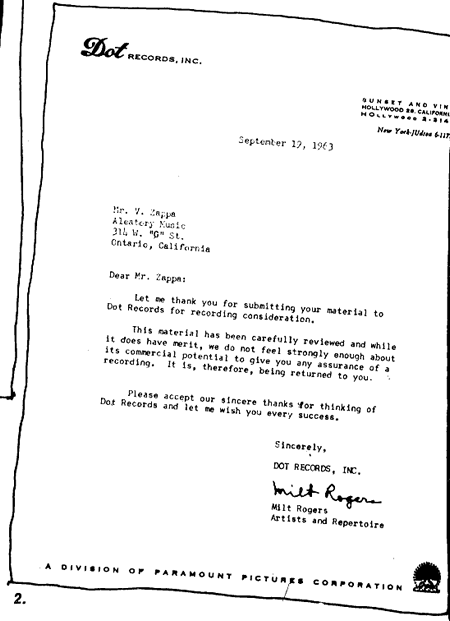
September 19, 1963
Mr. V. Zappa
Aleatory Music
314 W. "G" St.
Ontario, California
Dear Mr. Zappa:
Let me thank you for submitting your material to Dot Records for recording consideration.
This material has been carefully reviewed and while it does have merit, we do not feel strongly enough about its commercial potential to give you any assurance of a recording. It is, therefore, being returned to you.
Please accept our sincere thanks for thinking of Dot Records and let me wish you every success.
Sincerely,
DOT RECORDS, INC.
Milt Rogers
Artists and Repertoire
2. Material rejected by this notice include Any Way The Wind Blows, Take Your Clothes Off When You Dance (original instrumental version), master recordings of Don Vliet (Captain Beefheart) singing Slippin' & Slidin'. Last item was rejected by Mr. Rogers when questioned by phone after receipt of this notice on the grounds that "the guitar was distorted."
Another project in the summer of 1963 was the formation of the Soots, which brought Frank and Don Vliet together, along with guitarist Alex St. Clair and Vic Mortenson on drums. The group made several recordings, including 'Metal Man Has Won His Wings', 'Cheryl's Canon' and 'Slippin' And Slidin'', Don's take on Little Richard.
Songs reportedly recorded by The Soots according to FZ
| Sounds, 1970 |
Down Beat, 1983 |
TRFZB, 1989 |
TLE, 1996 |
date |
| "Slippin' And Slidin'" |
"Slippin' And Slidin'" |
"Slippin' And Slidin'" |
"Slippin' And Slidin'" |
rejected in September 19, 1963 |
| "Evil" |
|
|
|
|
| "The Grund" |
|
|
|
|
| "Tiger Roach" |
|
|
["Tiger Roach"] |
recorded after November 1964 |
| "Vicious Intentions" |
|
|
|
|
| |
|
"Metal Man Has Won His Wings" |
"Metal Man Has Won His Wings" |
recorded after February 1964 |
| |
|
"Cheryl's Canon" |
|
|
| |
|
|
"I'm Your Nasty Shadow" |
|
c. 1964—Run Home, Slow
My English teacher at A.V. was Don Cerveris. He was also a good friend. Don got tired of being a teacher and quit—he wanted to be a screenwriter. In 1959, he wrote the screenplay for a super-cheap cowboy movie called Run Home Slow, and helped me get my first film scoring job on it. [...]
After endless delays, Run Home Slow (starring Mercedes McCambridge) was completed and scored in 1963. I even got paid for it—not all of it, but most of it. I took part of the money and bought a new guitar, and used the rest to 'buy' Pal Records from Paul. In other words, I agreed to take over his lease and the rest of his debt.
Meanwhile, my marriage fell apart. I filed for divorce, moved out of the house on G Street, and into 'Studio Z,' beginning a life of obsessive overdubbage—nonstop, twelve hours a day.
The latest project was writing the score for a movie titled "Run Home Slow" which was finished about a month ago. It is yet to be released, Zappa said.
August 1, 1964—Studio Z
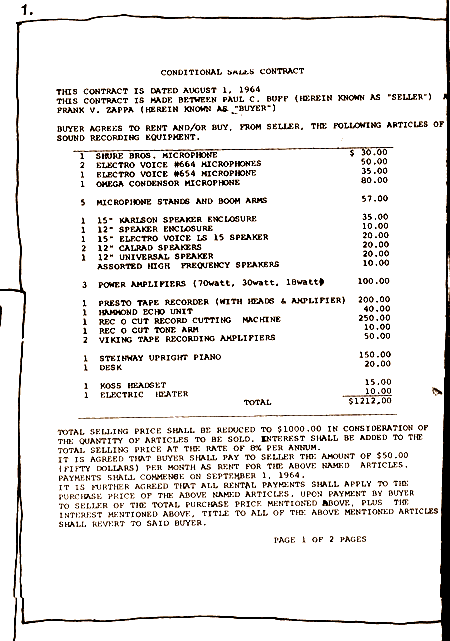
1. Bill of Sale for Cucamonga recording studio.
Paul Buff, in correspondence with Patrick Neve, March 16, 1998
When Allison and I got married and I got the gig with Art Laboe at Original Sound, I let Zappa use the studio for several months, then sold it to him for a little bit of money, his old drums set, his vibes and his Jazzmaster guitar (Which was later stolen from me at Original Sound).
Dave Aerni, in correspondence with Patrick Neve, March 22, 1998
Paul sold the studio to Frank, as you know, and began working with Oldie but Goodie (Art LaBoe) Records in Hollywood. Before this all happened I was busy producing Surfing dances and records and drifted away from the Cucamunga studio. I did some recordings with Paul at his new studio on Sunset Blvd.
It was crude, but it was comfortable. I remember that. It was just the kind of place where you could party all night long, and make a recording session out of it. So that's what happened . . . just before Alex [Snouffer] got back, Frank started to get together with Don.
[...] I didn't stay there every night of the week, but sometimes I would stay there two or three nights of the week. [...] Paul [Buff] was never around, and Frank was running the studio. He had the five-track Ampex with multiple recording heads and the whole business.
[...] Usually what would happen is he might lay down a guitar track and I'd lay down a rhythm track. Sometimes we had a bass man, sometimes we didn't. Sometimes he (Frank) would pick the bass, whatever. I would go to sleep on the old day-bed out there and he would go back into the studio, plug directly on the board, and lay down maybe "eighteen" (in an exaggerated voice) more guitar tracks. He would just go on and on and then he would come out and wake me and say, "Hey, listen to this, I want you to add something here." He had a grand piano in there, and I actually remember him sitting at the piano, fingering the chords, while I played on the strings with timpani mallets.
[...] By the time I got into that studio he'd already built the stage sets inside it. Bizarre sets. [...] I don't know whether it was going to be for one of the Beefheart things. He was just building really bizarre stuff, and then I think he wanted to do some kind of space movie. I mean, there was a room built within a room.
[...] Frank and I would stay there most of the week. And then the guys would come down on the weekend. [Don Van Vliet] and Doug [Moon] and Alex [Snouffer] would come down from Lancaster and we would jam. Sometimes, Don would come alone, sometimes the guys would come, maybe one would come.
FZ, interviewed by Ralph Denyer, Sound International, April/May 1979
One home-made 5-track recorder, a Presto mono deck for mix-downs and a homemade 8-channel board. There were about five or six microphones, a set of drums, two pianos and a bunch of floor space.
Additional informants: Tan Mitsugu, Javier Marcote (special thanks to Javier for finding and providing so much material)


















